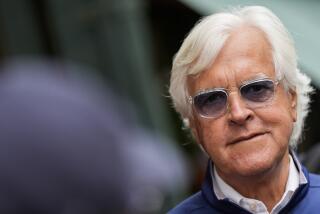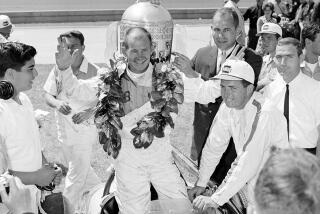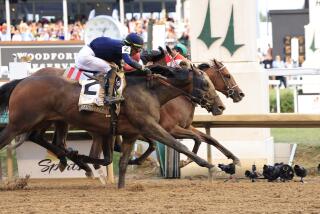Drivers Donât Like Darlington Track, but They Respect It
DARLINGTON. S.C. â I grew up thinking that the Southern 500 was about as important as the World Series, Kentucky Derby and the Indianapolis 500, all wrapped up into one. --Richard Petty
The Lady in Black, who will turn 39 today, is showing no signs of getting soft in her old age.
Darlington Raceway, carved from a South Carolina cotton field in 1950 as the first banked superspeedway in motor racing, has always had a strange sort of an egg-shaped figure that has puzzled and tantalized the worldâs greatest stock car drivers for four decades.
The track is so narrow and its turns so out of balance that frustrated drivers began calling it the Lady in Black, in keeping with its dangerous character. More recently, since the France family obtained control of the facility in 1982, it has been called, âThe Track Too Tough to Tame.â
The 40th annual Southern 500 will be run today on the lopsided 1.366-mile circuit, and todayâs drivers, Darrell Waltrip, Dale Earnhardt, Geoff Bodine, seem as much in awe of Darlington as did those of an earlier era, Curtis Turner, Fireball Robert, Junior Johnson and a young Richard Petty.
âYou walk around the old track and see how narrow it is and you think thereâs no way to race,â Waltrip says. âThen you go out and do it.â
Says Bodine: âDarlington is so treacherous that even when youâre warming up, you have the feeling that you might spin out at half-speed.
âItâs the Lady in Black all right. That long stretch of black asphalt shimmering in the heat can do strange things to your head. Sometimes youâll be coming out of a turn and youâll swear you see an oil slick. Itâs just the Lady in Black playing tricks on your mind.â
Alan Kulwicki, who will start on the pole today after qualifying at 160.156 m.p.h., likens driving here to a video racing game.
âItâs like where youâre driving along and all these obstacles jump up at you on the screen,â Kulwicki says. âDarlingtonâs a lot like that. You had better drive defensively because you never know just whatâll jump up next. You can be sure that it will be something, though.â
David Pearson, the retired Silver Fox from Spartanburg, S.C., has been the most successful driver here, having won 10 races and 12 pole positions.
âIt takes patience, prudence and tolerance to race at Darlington,â Pearson says. âCommon sense should dictate your moves. Itâs a real accomplishment just to finish a race here.
âThe track is so narrow and tight that you canât be too cautious in passing, even lapped cars. Iâve spent as many as 10 laps following a car that was decidedly slower than mine before Iâd attempt a pass because I was afraid I might wreck us both.
âThis old place is just as fickle as everybody says it is.â
Junior Johnson, who has one victory as a driver and eight as a car owner, mourns for the days when the Southern 500 was the belle of NASCAR.
âItâs kind of sad, sort of, that some of the young guys donât have the same feeling for Darlington that the old-timers have,â Johnson says. âNowadays, there are races that pay more, are faster and longer. But for folks who were around when all this started, there is a special feeling for this track and this race.
âThe newcomers, drivers and car owners, donât seem to have the same respect for it that we have. I remember when it was the most awesome event of our time. If you captured this race, it was like youâd whupped the king, as far as we were concerned.â
Waltrip, who drove for Johnson for six years before switching to Rick Hendrick three years ago, has similar feelings even though he was only 3 when the track opened.
âAll youâve got to do is just be here to feel history all around you,â Waltrip says. âOver there in the fourth turn is where Richard (Petty) flipped in â70, and over there is where Cale (Yarborough) went out of the ballpark in â65, and you canât see it today but over where that concrete is in the east turn is where the Darlington stripe got its name.â
The Darlington stripe evolved when drivers--some say it was Red Byron who first did it in his Cadillac in the early 1950s--discovered that if the rear ends of their cars hit the guard rail between the third and fourth turns, it increased their lap speeds. Consequently, car owners and fans could tell who were the bravest--and fastest--drivers by looking at the carsâ right rear fenders.
If a car had a bare spot there, it was where the paint had been scrubbed off by the guard rail. That was the badge of courage that became known as the Darlington stripe.
âIf I could put roller skates on the side of my car, the turn would be perfect,â Fireball Roberts once said.
In 1969, though, the turn was widened and in 1974 the guard rail was replaced by a concrete barrier and the Darlington stripe became a legend of the past.
Darlington Raceway did not open until Labor Day, 1950, but the idea for an Indianapolis of the South had been germinating in Harold Brasingtonâs mind since 1933. Brasington, a Darlington contractor and devoted fan of Carolina dirt-track racing, had seen the Indianapolis 500 that year and felt that the South would welcome a similar facility for late model stock cars.
Up until then, outside of the race on the beach at Daytona, there were no tracks where stock cars ran that were longer than a mile and all of them were dirt.
By 1949 Brasington had made enough money so that, with the help of several cronies, he set out to build a paved track on some farmland west of the tiny South Carolina farming community, out alongside Hartsville Highway.
As Brasington was bulldozing his track, though, he encountered a problem. It seemed that one of the landowners, who had traded 70 acres of cropland for shares in the new track, also had a minnow pond on the property--and it was right in the path of Brasingtonâs track.
The minnows were used as fishing bait and fishing had been a way of life on the Carolina Piedmont during the Depression years.
No problem. The configuration of the original 1 1/4-mile track was changed to accommodate the pond, which remains just a few yards from the southwest turn.
The result was that the first and second turns were pinched closer together than the more sweeping third and fourth turns. Drivers, mechanics and engineers have been trying to live with that situation ever since.
âItâs like running a road course set-up on an oval,â says Rusty Wallace. âYou get the car balanced for (Turns) 1 and 2 and youâre completely off for 3 and 4. Or the other way around. Youâve got to find a compromise, and then youâve got to keep your car off the walls. Itâs a devil to drive.â
There is barely room enough for cars to drive two abreast on the two long 1,200-foot straightaways, much less in the oddly-banked turns. The banking is 22 degrees through the first and second turns and 24 degrees on the other end of the track.
âWe wanted banking that would give us speeds of 75 to 100 m.p.h.,â Brasington once said--a statement often ridiculed today.
âWeâre going 160 on a track built for 100,â says Richard Petty, who won the 1967 Southern 500 but has lost some of his enthusiasm regarding Darlington since his accident in 1970. âThatâs not too smart, running 1990 speeds on a 1950 track.
âIâd rather race most anywhere than Darlington. I have no love for the race track, but plenty of respect. The thing rose up and bit me in 1970.â
Nevertheless, Petty will be making his 30th appearance in the Southern 500.
The first Southern 500, although it wasnât called that until a few years later, was won by Californian Johnny Mantz, who drove a Plymouth that he, Bill France, Curtis Turner and Alvin Hawkins had used to run errands. Mantz, an Indianapolis 500 veteran, had expected to land a ride in one of the top cars in the fledgling NASCAR camp but when he didnât, he decided to drive the store-bought passenger car.
Mantz won after nearly all the favorites had dropped out with blown tires or blown engines. He averaged 76 m.p.h. in a race that lasted more than 6 1/2 hours.
By contrast, todayâs race should last less than four hours.
One thing that has changed little is the crowd--a sweltering mob loaded down with beer, Confederate flags and Johnny Reb hats that will spill out from the more than 40,000 seats and pack the infield.
Brasington was hoping that 5,000 spectators would show up for his first Labor Day race and the result was overwhelming as closer to 25,000 jammed the narrow winding roads from all over the Southeast.
There are 45,000 grandstand seats now, and with an additional 20,000 people jammed in the infield, the crowd is expected to reach 65,000. Brasington, who no longer is associated with the track, is still promoting, however. He runs Darlington International Dragway, about five miles from his old track, and next Saturday will have the International Hot Rod Assn.âs U.S. Open.
For nine years, Darlington was the only superspeedway in NASCAR. Then Daytona was built in 1959 and the flood gates opened for tracks such as Charlotte, Atlanta, Rockingham and, later, Talladega.
When the Francesâ International Speedway Corp. bought the Darlington facility for $4.5 million, it set about to upgrade the track and grounds--but not to tamper with the track. âWeâll continue to make improvements from race to race, but we have no intention of altering the racing surface,â said Jimmy France, executive vice president of ISC and youngest son of Bill France, the founder of NASCAR. âThat is tradition we wonât tamper with.â
Or, as Waltrip says: âNo one would dare touch up the Mona Lisa. The track at Darlington shouldnât be tampered with either.â
The one thing different this year is the raceâs official name--the Heinz Southern 500.
In keeping with a trend toward corporate sponsorship of major sporting events, Darlington Raceway signed a three-year agreement last June with the Pittsburgh-based food products company. This leaves only two of the 29 Winston Cup races without commercial names--the Daytona 500 and the Charlotte 500.
More to Read
Go beyond the scoreboard
Get the latest on L.A.'s teams in the daily Sports Report newsletter.
You may occasionally receive promotional content from the Los Angeles Times.










